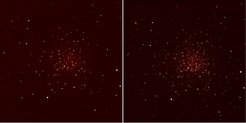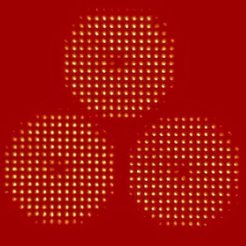First corrected images with ARGOS GLAO

The lasers of the ARGOS Ground Layer Adaptive Optics (GLAO) system were propagated from the two sides of the LBTO telescope for the first time on 5 November 2013. Slightly more than one year later, at the end of November 2014, the LBTO adaptive optics was locked on the three laser guide stars of the ARGOS constellation on the right side of the telescope, achieving an impressively good correction on the whole field of LUCI2.
The astronomers were able to obtain images in the J, H and K band with a resolution of 0.3 to 0.4 arc-seconds by using the GLAO correction to improve the images from 0.7 to 1 arc-second uncorrected seeing. The best corrected images reach even 0.22 arc-seconds in K, which means an improvement of a factor of 4 (in the PSF) over natural seeing.

The three LGS wavefront sensors in closed loop.
This is a very important step in the development of ARGOS, auguring well for the final performance of the LUCI1-LUCI2-ARGOS combination, i.e. the main instruments for both telescopes and the laser adaptive optics system.
After passing this milestone, however, there is still much work to be done with ARGOS: the first half of 2015 will see fine-tuning and streamlining of the operations. This will be followed by the installation of the left-side wave front sensors on the telescope in the summer of 2015, and commissioning them in the last months of 2015. The whole system will then be integrated into the observing environment and extensively tested in binocular mode. A release to the science community is currently envisioned for mid-2016.













